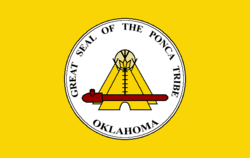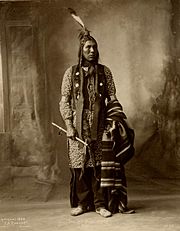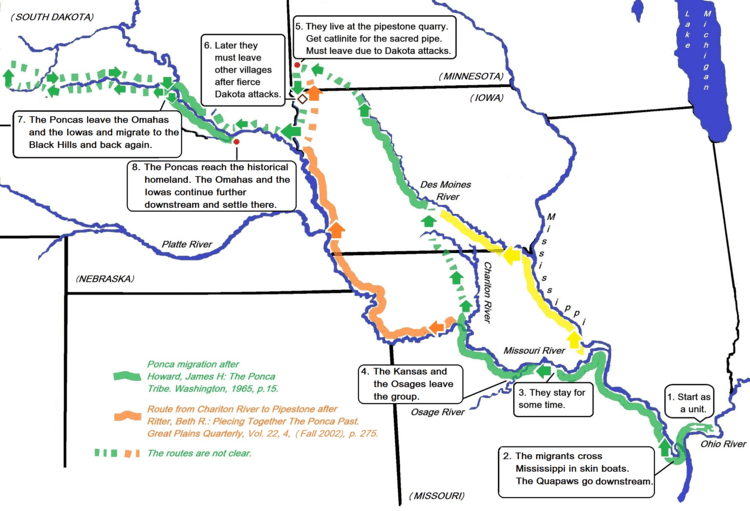Ponca facts for kids

Flag of the Ponca Tribe of Oklahoma
|
|

Flag of the Ponca Tribe of Nebraska
|
|
| Total population | |
|---|---|
| 6,700 | |
| Regions with significant populations | |
( |
|
| Languages | |
| English, Omaha-Ponca | |
| Religion | |
| Native American Church, Christianity | |
| Related ethnic groups | |
| Omaha and other Dhegihan/Siouan peoples |
The Ponca are a group of Native American people. They are part of the Siouan language family. Their language is called Páⁿka or Ppáⁿkka.
Today, there are two main groups of Ponca recognized by the United States government. These are the Ponca Tribe of Nebraska and the Ponca Tribe of Indians of Oklahoma.
The Ponca people have a long history. Their stories say they originally lived east of the Mississippi River. This was in the Ohio River valley area. They later moved west to find more game. They also moved because of wars with the Iroquois tribe. The name Ponca means "Those Who Lead."
Contents
Early Ponca History
When Europeans first arrived, the Ponca lived near the Niobrara River in northern Nebraska. Their traditions say they moved there from east of the Mississippi River. This move happened just before Christopher Columbus came to the Americas.
Other tribes, like the Omaha and Osage, also moved west. They were pushed out of the Ohio River area by the Iroquois. This happened during a time known as the Beaver Wars.
First European Contacts
The Ponca first appeared on a map in 1701. The map was made by Pierre-Charles Le Sueur. He showed them living along the upper Missouri River.
In 1789, a fur trader named Juan Baptiste Munier traded with the Ponca. He found about 800 Ponca people living near the Niobrara River. Soon after, a terrible smallpox sickness hit the tribe.
By 1804, when Lewis and Clark visited, only about 200 Ponca remained. Later in the 1800s, their numbers grew to about 700.
In 1824, many Ponca leaders were killed. They were attacked by Lakota warriors while returning from a friendly visit. Only twelve leaders survived this attack.
Unlike many other Plains Indians, the Ponca grew maize (corn). They also had vegetable gardens. Their last big buffalo hunt was in 1855.
Treaties with the United States
The Ponca signed a peace treaty with the United States in 1817. In 1825, they signed another treaty. This treaty helped control trade and reduce fighting between tribes.
In 1858, the Ponca gave up some of their land to the US. In return, they were promised protection from other tribes. They also received a permanent home on the Niobrara River.
Their last treaty with the US was in 1865. But in 1868, the US made a mistake in a treaty with the Sioux. The US accidentally included all Ponca lands in the Great Sioux Reservation. This caused problems between the Ponca and the Sioux. The US then decided to move the Ponca from their own lands.
Forced Relocation
In 1876, the US government decided to move several tribes to Indian Territory. This area is now Oklahoma. The Ponca were on this list.
Ponca chiefs went to see the new lands. They found the land was not good for farming. So, they decided not to move.
In early 1877, government officials came to move the Ponca. The chiefs refused, reminding them of their earlier treaty. Most of the tribe did not want to leave. They had to be moved by force.
Life in the new location was very hard. The Ponca suffered from malaria and a lack of food. The hot climate was also difficult. Sadly, one out of every four Ponca people died in the first year.
Chief Standing Bear
Chief Standing Bear strongly protested the tribe's forced move. His oldest son, Bear Shield, was dying. Standing Bear promised to bury him in their old homeland.
To keep his promise, Standing Bear left the reservation in Oklahoma. He traveled back towards the Ponca lands. He was arrested for leaving without government permission. He was held at Fort Omaha.
Many people supported Standing Bear's cause. Two important lawyers helped him for free. Standing Bear filed a lawsuit to challenge his arrest. This type of lawsuit is called a habeas corpus suit.
In 1879, the case Standing Bear v. Crook was heard in Omaha, Nebraska. The court decided that Native Americans are "persons within the meaning of the law." This meant they have certain rights under US law. This case was a very important step for civil rights in the United States.
Ponca Tribe of Nebraska
In 1881, the US government returned some land to the Ponca. This was 26,236 acres in Knox County, Nebraska. About half of the tribe moved back north from Indian Territory.
In the 1930s, scientists studied an old Ponca village. They found large circular homes up to sixty feet wide. These homes were along the Niobrara River.
After World War II, the US government changed its policy. It tried to end its relationship with tribes. In 1966, the government ended its recognition of the Northern Ponca tribe. The tribe's land was divided among its members. Much of it was later sold.
In the 1970s, the tribe began working to get recognized again. They wanted to bring back their culture and help their people. On October 31, 1990, the Ponca Tribe of Nebraska was federally recognized again.
Today, the Ponca Tribe of Nebraska has over 2,783 members. Their main office is in Niobrara, Nebraska. They are the only federally recognized tribe in Nebraska without a reservation.
Ponca Tribe of Oklahoma
After the forced move in 1877, the tribe settled in Indian Territory. This was on their own lands along the Arkansas River and Salt Fork Rivers. Some members lived in a tipi village. Others settled near the Chikaskia River.
The US government then tried to change how tribes were governed. They wanted Native Americans to live more like other Americans. Under the Dawes Act in 1891 and 1892, reservation lands were divided. Each tribal member received a piece of land. Any land left over was sold to non-Native people.
After Oklahoma became a state, some Ponca land was leased or sold. Many Ponca people found jobs at the Miller Brothers 101 Ranch.
In 1911, oil was discovered on Ponca lands. This brought money but also problems. Oil refineries sometimes dumped waste directly into the Arkansas River.
In 1918, two Ponca men, Frank Eagle and Louis McDonald, helped start the Native American Church.
In 1950, the tribe formed a new government. They adopted their own tribal constitution on September 20, 1950.
Today, the Ponca Tribe of Oklahoma has over 4,200 members. Their main office is in White Eagle, Oklahoma. They also do business from Ponca City.
Notable Ponca People
- Standing Bear, a chief and important civil rights leader
- Paladine Roye, a painter (1946–2001)
- Ponka-We Victors, a state legislator in Kansas
- Clyde Warrior, an activist who worked for Native self-determination
- Tommy Morrison, a former heavyweight boxer and actor
- Carter Camp, a leader in the American Indian Movement (AIM)
- Brett Chapman, an attorney and advocate for Native American rights
See also
 In Spanish: Ponca para niños
In Spanish: Ponca para niños



